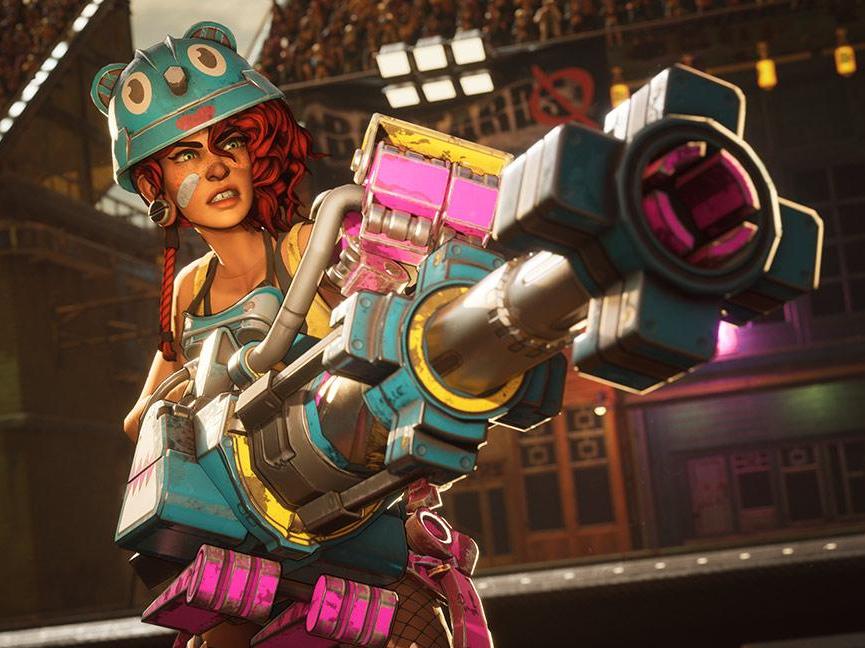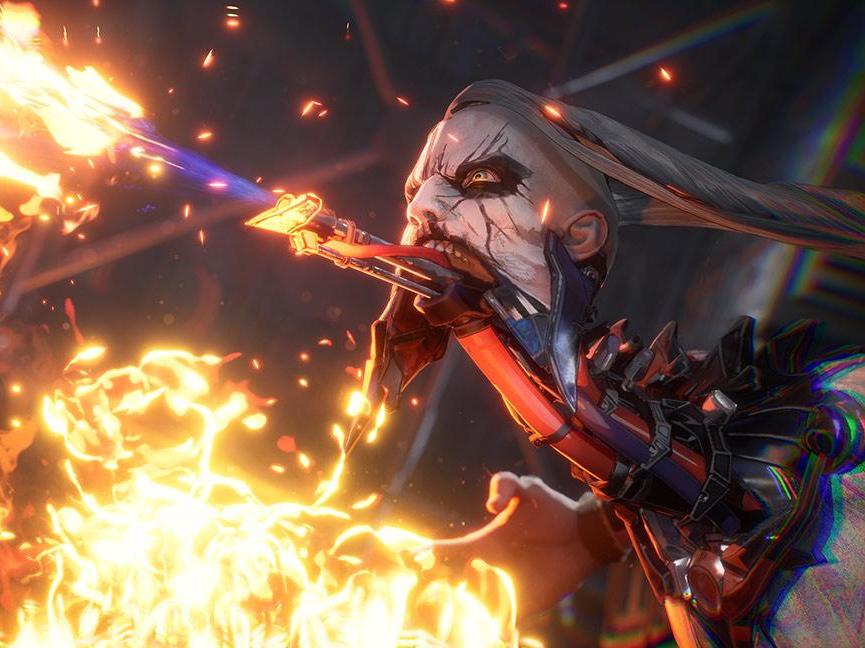Inside ‘Bleeding Edge’ – a great multiplayer game for those who are sick of Fortnite
Ninja Theory’s first foray into online multiplayer action strives to do something new with the genre – and succeeds in style, says Louis Chilton


For the last decade, the world of online gaming has seemed like a gold rush; every so often, somebody gets to yell “bonanza!” Games like Fortnite, League of Legends and Overwatch have managed to slip into the bloodstream of the popular imagination, accumulating tens of millions of players, all competing against each other from the comforts of their own home.
With the coronavirus pandemic forcing everybody indoors for the long haul, it’s no surprise that online gaming numbers have shot up. In a time of social distancing, online gaming is a means of bringing people closer together. All of which is to say that Bleeding Edge, the new multiplayer battle game from developer Ninja Theory, could not have come at a better time.
Since the juggernaut success of Fortnite, online gaming has pivoted its attention towards battle royale-style setups, in which players are pitted against each other, vying to be the last person standing. Bleeding Edge was to be something totally different – something quite unlike anything that has come before.
At least, that’s what Bleeding Edge’s creative director Rahni Tucker tells me when I visit the Ninja Theory team at their studio in Cambridge. “Where is this game?” she asked herself, when she was first germinating the idea for the project. “Where’s third-person action meets competitive team multiplayer? It doesn’t exist. Not the way I imagined it.”
Anarchy Reigns is cited as the closest predecessor, but – crucially – it was missing the focus on team-based gameplay. So she, along with the Ninja Theory team, decided to make it happen for themselves.
In Bleeding Edge, you play in two teams of four. The action is all third-person, and the combat is based around teamwork and co-operation. You are encouraged to hunt in packs; the John McClane approach simply won’t cut it here. It’s fun, addictive action, with an eye-catching aesthetic, and the gameplay combination is a winning one.
Coming from Australia, Tucker had a background in creating video games for the children’s market before Bleeding Edge. “That was clearly a different audience to yourself,” she explains. “When you’re making a game for a 12-year-old, or an 8-year-old, you’re trying to put yourself in someone else’s shoes and imagine what they would want to play. This game’s definitely not like that. It’s for us – for gamers like us.”
Back when Bleeding Edge was first decided upon, Ninja Theory were pretty much strangers to the multiplayer format. They were known for their single-player games, most prominently the DmC: Devil May Cry 2010 reboot, and 2017’s critically lauded Hellblade: Senua Sacrifice – the latter of which bought them the leverage to make Bleeding Edge, after the studio was acquired by Microsoft in 2017.
Ask anyone at Ninja Theory, and they will tell you that little has changed under their new auspices. If anything, Microsoft appears to play the role of the muted investor, stepping in only when Ninja Theory find themselves out of their depth. “Day to day, it’s had no impact to us”, says Tucker. “It hasn’t affected our creativity in any way.”
What’s more, the sprawling infrastructure of Microsoft and Xbox have given the developers unprecedented support in the back end – in everything from online services, match-making setups and securing credentials, to mastering and shipping builds on a regular basis. “Anything that would be costly or tricky as an indie has been made a lot easier,” Tucker insists. Plus, Microsoft has experience making their games backward-compatible on new consoles – a potentially important point, given that the new Xbox Series X is set to launch in a matter of months.
This must be immeasurably useful, especially when working with a small team – which Ninja Theory undoubtedly is. Before the Microsoft acquisition, the studio had described themselves as “Independent AAA”, creating games with a high budget (“AAA”) feel, but with lower costs and expanded creative license.
Ninja Theory still has the feel of an independent studio; Bleeding Edge started out with a team of just six people, which later grew to an average of 15. As a point of comparison, multiplayer behemoth Fortnite is worked on by the majority of Epic Games’s roughly 700-strong workforce. You still feel, despite the studio’s decorated back-catalogue and the flashes of Microsoft branding seen around the building, that the team’s underdog spirit endures.
Although the game’s creative director was adamant about Bleeding Edge’s core principals, the game’s finer points had to be worked out through trial and error. “We let the game find its own way, nurturing it as it went,” says Tucker. Setups were trialled with different numbers of competitors on each team – 3v3, 5v5, 6v6 – and every day, the development team would playtest the game and make adjustments.

The most vivid indication of the difficulties involved in switching from single-player game development to online multiplayer came from Bleeding Edge’s audio department: Daniele Galante, the senior sound designer and David Garcia, the audio lead.
Together, they explained how the “much more controlled environment” of a single-player game like Hellblade only requires one perspective for sound – all noises are produced relative to the position and actions of the sole player. For Bleeding Edge, each match requires eight different idiosyncratic audio experiences, with each player’s soundscape subject to the multiplex of movements, actions and decisions of all the other players.
With everything going on, it is the job of the audio team to make sure the game automatically prioritises the right sounds on a case-by-case basis – that you are able to hear danger coming, for instance, and not be cacophonised by the errant activity of some nearby teammate. The whole shebang involves a complicated multi-track audio system that Robert Altman would likely balk at. And Galante and Garcia had to learn it on the fly.
Bleeding Edge has a bright, distinctive look, closer to the coruscating shades of Borderlands than the charmless caricatures of Fortnite. Lead artist Aaron McElligott and principal animator Warwick Mellow explained the game’s aesthetic influences. Finding most western equivalents rather drab, they looked to Japan for inspiration.
“We knew we were going to be making a fast-paced, arcade-style fighting game,” said Mellow, “so we looked at fast-combat anime, with clearly readable action.” They started with seminal anime films Akira and Ghost in the Shell, but found that the dark, gritty look didn’t chime with the fun feel of the gameplay. So they turned to the lesser-known Tekkonkinkreet. Released in 2006, Tekkonkinkreet was a punchy, visually exquisite piece of work that boasted sprawling, colourful cityscapes; Bleeding Edge borrows from it deftly.
The game’s characters are varied, and memorable – ranging from the self-consciously “cool” (like the gun-toting Gizmo), to the thematically arch (like the heavy metal-inspired Níðhöggr), to the outright ridiculous (like Mekko, a super smart dolphin in a weapon-mounted water tank). It’s a bizarre melange of genres that only works so well because of the cohesive visual style. Tucker even wrote elaborate, amusing back stories for all the characters, although most players are likely to breeze past the chunks of text to get straight to the action.
There are plans in place for Bleeding Edge’s future, in the months and years after its launch – such as the option to team up with specific people when matchmaking, and the possibility of competitive play (“We are pushing for the game to be competitive”).
It’s impossible to predict whether people will take to a video game – some of the industry’s biggest hits can spring from seemingly nowhere. But Bleeding Edge has all the makings of a multiplayer sensation: great visuals, addictive action and a fresh (if not completely unique) angle. In this time of interpersonal distance and enforced antisociality, the chance to team up and get stuck in with three complete strangers might be just what we all need.
‘Bleeding Edge’ is available on Xbox One and PC now
Join our commenting forum
Join thought-provoking conversations, follow other Independent readers and see their replies
Comments